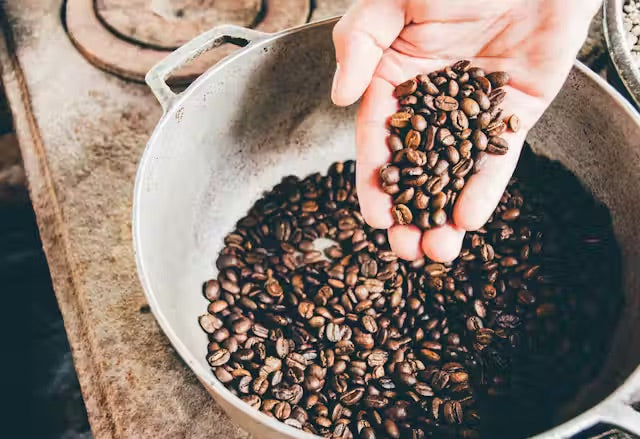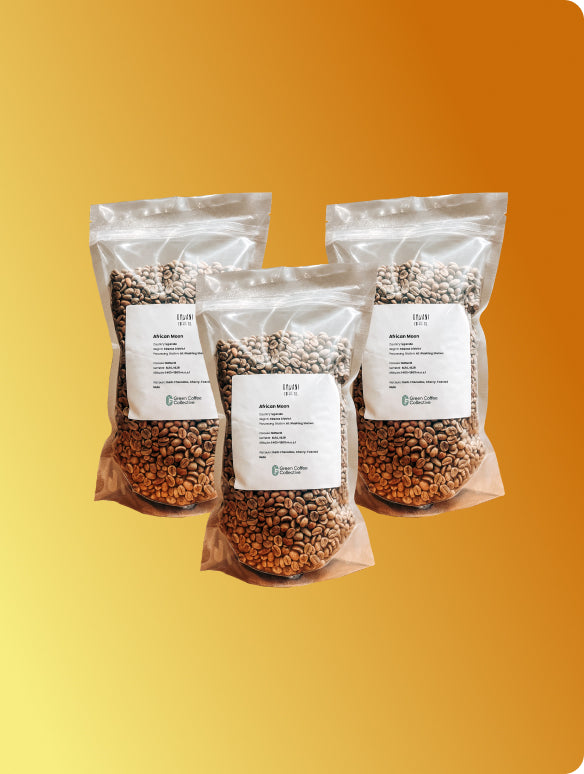Introduction: Why You Need the Right Equipment for Home Coffee Roasting
Roasting your own coffee beans at home is an incredibly rewarding experience that allows you to enjoy the freshest, most flavourful coffee tailored to your taste. However, achieving great results requires the right equipment. Whether you're a beginner or looking to refine your roasting skills, having the essential home coffee roasting equipment will ensure that you can roast coffee beans to perfection.
Choosing the Best Coffee Roasting Method for Home Roasting
The cornerstone of any home coffee roasting setup is the coffee roasting method. The right coffee roaster can make all the difference in achieving an even roast with consistent flavour.
There are several types of coffee roasters suitable for home use:
- Popcorn Popper: A popular and affordable option for beginners. Popcorn poppers can roast small batches of coffee and offer an easy introduction to home coffee roasting. Just be sure to choose a model without a mesh screen to avoid the risk of fire.
- Dedicated Home Coffee Roaster: For those serious about coffee roasting, investing in a home coffee roaster is the way to go. These machines offer more control over roasting variables, such as temperature and roast time, ensuring an even roast every time. Some recommended brands include [Your Brand Recommendation Here].
- Stovetop, Gas Burner or Oven Roasting: These methods require more skill but are budget-friendly options. With a bit of practice, you can achieve good results using equipment you already have at home. However, controlling the roast can be more challenging compared to using a dedicated roaster.
Equipment for Stovetop or Oven Roasting
Stovetop and oven roasting are accessible methods for home coffee roasting that don't require a significant investment in specialized equipment. However, to achieve the best results with these methods, you'll need a few key pieces of equipment depending on the approach your choose:
1. Heavy-Duty Pan or Skillet
For stovetop roasting, a heavy-duty pan or skillet is essential. Cast iron skillets are particularly popular because they retain and distribute heat evenly, which is crucial for achieving a consistent roast. Ensure the pan is large enough to allow the beans to move freely, which helps prevent uneven roasting.
Tip: Stir the beans constantly while roasting to ensure even heat distribution and avoid burning.
2. Roasting Over a Gas Burner
Roasting coffee beans over a gas burner is a popular method that offers precise temperature control. Here’s what you’ll need:
- Wok or Pan with a Lid: A wok works well over a gas burner because its shape allows for easy stirring and even heat distribution. A lid can help retain heat and control the roasting environment.
- Ceramic Handheld Coffee Roaster: A ceramic handheld coffee roaster is a specialised tool designed for use over a gas burner. Its unique design allows you to hold and shake the beans directly over the flame, giving you excellent control over the roast. The ceramic material provides even heat distribution, and the handheld design makes it easy to keep the beans in constant motion, which is essential for even roasting.
- Perforated Pan or Mesh Colander: If you prefer, you can use a perforated pan or mesh colander over the burner to allow direct contact with the flame. This setup requires constant movement to prevent scorching but can produce excellent results.
- Gas Burner: A stable, adjustable gas burner provides the direct heat needed for this roasting method. Adjust the flame to control the temperature and achieve the desired roast level.
3. Roasting with a Baking Sheet
If you’re using the oven method, a quality baking sheet is required. Choose one with a rim to keep the beans contained and make stirring easier. An aluminium or stainless steel baking sheet will provide even heating, helping you achieve a more uniform roast.
Tip: Spread the beans out in a single layer on the baking sheet to ensure even exposure to heat.
4. Oven Thermometer
Oven temperatures can vary widely from the setting on the dial, so an oven thermometer is crucial for monitoring the actual temperature. This tool ensures you’re roasting at the correct temperature, helping you avoid under or over-roasting your beans.
5. Stirring Utensils
A long-handled wooden spoon or heat-resistant spatula is necessary for stirring the beans regularly. Consistent stirring helps distribute heat evenly and prevents scorching, especially with stovetop roasting.
6. Cooling Rack
After roasting in the oven, transfer your beans to a cooling rack. This allows air to circulate around the beans, cooling them quickly and stopping the roasting process. A mesh cooling rack works best to prevent any beans from falling through.
7. Heat-Resistant Gloves
Handling hot pans, baking sheets, and beans requires heat-resistant gloves. These are essential for safety, particularly when transferring hot items from the stovetop or oven.
Advantages and Considerations
Stovetop, gas burner and oven roasting are great for beginners because they use equipment you likely already have in your kitchen or that you can obtain relatively cheaply. However, they do require a bit more hands-on attention to achieve an even roast. With practice, you can produce excellent coffee using these methods.
Cooling Methods: How to Stop the Roast at the Perfect Time
Once your coffee beans have reached the desired roast level, it's crucial to cool them quickly to stop the roasting process and lock in the flavor. Here are some effective cooling methods:
- Box Fan: A simple and affordable cooling method that works well for small batches. Spread the beans on a tray and place them under a fan to cool quickly.
- Cooling Tray: For larger batches, a dedicated cooling tray designed specifically for coffee beans is highly effective. These trays typically include a fan to speed up the cooling process and are available in various sizes to match your roasting volume.
- DIY Cooling Solutions: If you're handy, you can build your own cooling setup. However, purchasing a ready-made cooling tray can save you time and ensure consistent results.
Must-Have Accessories for Home Coffee Roasting
To achieve the best results, you'll need a few essential accessories alongside your coffee roaster and heat source. These tools will help you monitor and control the roasting process with precision:
- Thermometer: Monitoring the temperature of your beans during roasting is crucial for consistency. Choose a reliable thermometer, preferably one designed for high temperatures.
- Timer: Keeping track of roast times is essential, especially when experimenting with different roast levels. A timer helps ensure you achieve the desired roast profile every time.
- Oven Mitts: High-temperature oven mitts are necessary for handling hot equipment safely, especially if you’re using a roasting drum or stovetop method.
- Scale: Accurate measurements are key to consistent roasting. A digital scale allows you to measure your green coffee beans precisely before each roast.
- Storage Containers: After roasting, store your beans in airtight containers with degassing valves to keep them fresh. These containers prevent exposure to air, light, and moisture, all of which can degrade the coffee’s flavour.
Selecting and Storing Green Coffee Beans
The quality of your roasted coffee depends heavily on the green coffee beans you choose. When selecting green beans, consider:
- Origin: Different regions produce coffee with distinct flavor profiles. Experiment with beans from various countries to find your favourite.
- Processing Method: Washed, natural, and honey-processed beans each have unique characteristics that influence the final flavour of your roast.
- Storage: Store your green beans in a cool, dry place away from direct sunlight. Proper storage will preserve their quality until you’re ready to roast.
How to Choose the Right Storage Containers for Roasted Coffee Beans
After roasting, it’s vital to store your beans properly to maintain their freshness and flavour. The right storage containers make a big difference:
- Airtight Containers: Choose containers that seal tightly to keep out air, light, and moisture. Look for options with degassing valves, which allow CO2 to escape without letting oxygen in.
- Material Matters: Glass, ceramic, or non-reactive metal containers are preferred as they don’t impart any unwanted flavours to your coffee.
- Avoid Clear Containers: While visually appealing, clear containers allow light to penetrate, which can degrade the quality of your coffee beans. Opt for opaque containers instead.
If you'd like to read more about the best approach to storing coffee after you've roasted it you can check out our Coffee Roasters Guide to Storing Coffee Once It's Been Roasted.
Setting Up Your Home Roasting Space
Creating a well-organised roasting space at home will make the process smoother and more enjoyable. Consider the following tips:
- Ventilation: Ensure your roasting space is well-ventilated to avoid smoke buildup. Roasting outdoors, in a garage, or near an open window with an extractor fan can help.
- Safety First: Keep your roasting area free from clutter and flammable materials. Always have a fire extinguisher on hand, especially when using high-temperature equipment.
- Accessibility: Arrange your equipment and accessories within easy reach. This organisation will help you manage the roasting process more efficiently.
Conclusion: Start Your Home Coffee Roasting Journey with Confidence
With the right equipment and a bit of practice, home coffee roasting can be a highly rewarding hobby. Whether you're using a simple popcorn popper or a dedicated home coffee roaster, having the essential tools and accessories will ensure your roasting experience is a success. Start your journey today and enjoy the satisfaction of brewing the freshest, most flavourful coffee right at home.

